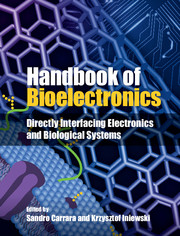Book contents
- Frontmatter
- Contents
- List of Contributors
- 1 What is bioelectronics?
- Part I Electronic components
- Part II Biosensors
- Part III Fuel cells
- Part IV Biomimetic systems
- Part V Bionics
- 22 Introduction to bionics
- 23 Bioelectronic interfaces for artificially driven human movements
- 24 The Bionic Eye: a review of multielectrode arrays
- 25 CMOS technologies for retinal prosthesis
- 26 Photovoltaic retinal prosthesis for restoring sight to the blind
- Part VI Brain interfaces
- Part VII Lab-on-a-chip
- Part VIII Future perspectives
- Index
- References
23 - Bioelectronic interfaces for artificially driven human movements
from Part V - Bionics
Published online by Cambridge University Press: 05 September 2015
- Frontmatter
- Contents
- List of Contributors
- 1 What is bioelectronics?
- Part I Electronic components
- Part II Biosensors
- Part III Fuel cells
- Part IV Biomimetic systems
- Part V Bionics
- 22 Introduction to bionics
- 23 Bioelectronic interfaces for artificially driven human movements
- 24 The Bionic Eye: a review of multielectrode arrays
- 25 CMOS technologies for retinal prosthesis
- 26 Photovoltaic retinal prosthesis for restoring sight to the blind
- Part VI Brain interfaces
- Part VII Lab-on-a-chip
- Part VIII Future perspectives
- Index
- References
Summary
During the course of a normal day, there are numerous physical tasks to be accomplished that require control of one’s arms and legs. For individuals with a neurological disease, motor disorder, or physical injury, the ability to control their arms or legs may be impaired or completely removed. One rehabilitative method to restore some function of movement would be to use a bioelectronic interface to provide a communication pathway between the nervous system and either the control of an external device or improved control of the existing limb. Successful bioelectronic interfaces require efficient and robust communication between external hardware and the nervous system in order to drive human movements. An ultimate solution would be a device that could “speak” the same language as the neural network it is communicating with to produce biofidelic functionality. In the following chapters (Chapters 24–26), a description will be given of how devices such as retinal prostheses perform the task of converting visual scenes into neural stimulation patterns to restore a sense of vision. Subsequent chapters (Chapters 27–34) will cover the different technologies available for using neural recordings for brain–machine interfaces (BMI). Again, this requires decoding neural signals from the cortex to properly control objects such as a computer mouse. This chapter will describe how neural recordings can be decoded to provide control signals for producing human movements in either the arms or the legs. Depending on the application, this may involve reanimating the existing limbs through methods of functional electrical stimulation (FES) or providing control signals derived from neural recordings to activate prosthetic limbs [1–12]. This chapter will begin with a brief discussion of the general flow process involved in designing an effective bioelectronic interface for artificial movements. The next two sections will discuss examples of bioelectronic interfaces for upper arm movements (reach and grasp) and lower leg movements (locomotion).
- Type
- Chapter
- Information
- Handbook of BioelectronicsDirectly Interfacing Electronics and Biological Systems, pp. 281 - 293Publisher: Cambridge University PressPrint publication year: 2015

